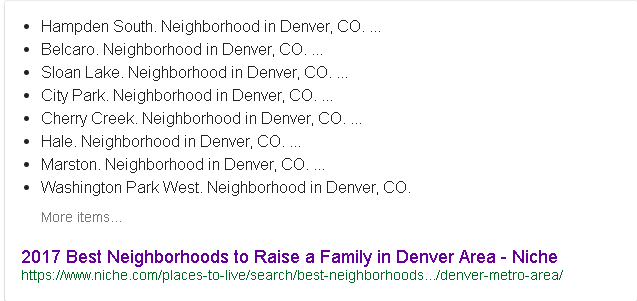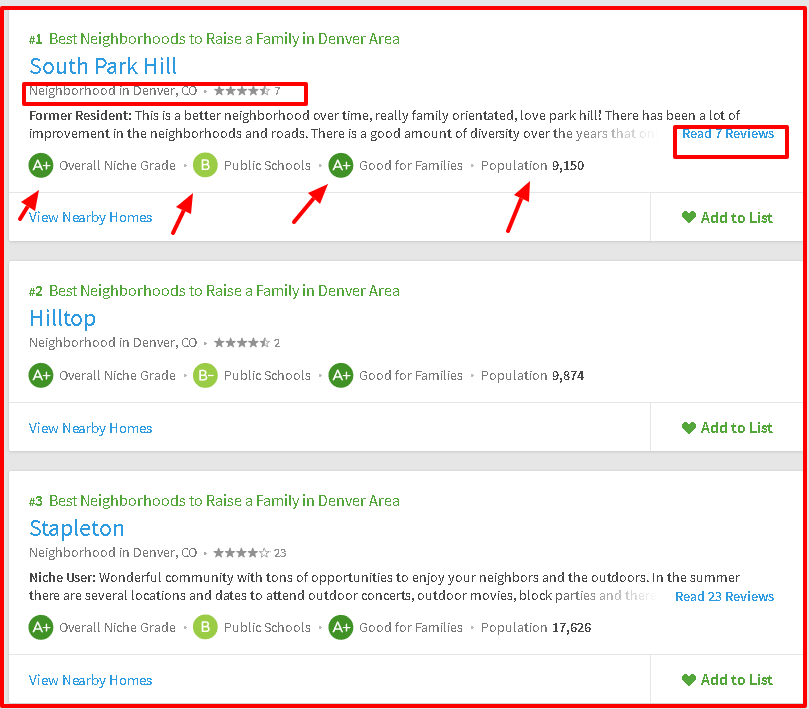What is the definition of Inbound Marketing?
Inbound marketing is an increasingly popular style of marketing built around the ideas of attraction and attention. In brief, a person doing inbound marketing would focus on creating quality content that organically generates attention as people surf the web looking for information, products, and entertainment. Here’s an example: Let’s say you are interested in buying a new home. You know you want a home for $450,000 in Denver that has access to a great public school. You do the following search.
“Best neighborhood in Denver for schools around $450,000”
Here is the FIRST search result.

This whole website – Niche.com is an example of Inbound Marketing. The website is ANTICIPATING questions or needs that you might have then creating answers. Here is the page Google thinks is best for our search:
“Best neighborhood in Denver for schools around $450,000”

Creating content that people actually want to look at pulls those people naturally to your website, and thus your services and/or products, which makes it easier to close sales — they came for a reason, after all.
Still don’t get the “Inbound Marketing” concept?
That’s okay, inbound marketing overthrows the marketing practices that have been in place for the last several decades, so it’s bound to sound a little strange.
We’ll break it down a bit.
Let’s say you have a Los Angeles-based company that sells a particular style of running shoes. You could do the standard issue marketing practices—buy ads in a newspaper or rent space on a billboard—or you could try your hand at inbound marketing by writing an article titled “The Top Ten Places to Run in Los Angeles.” But how, you ask, is this going to sell shoes?
Well, people primarily use search engines like Google, Yahoo, and Bing to do three things:
To do something—“I want to buy a ticket to the next Eddie Izzard show.”
To learn something— “Where can I find the best dim sum in San Francisco?”
To get somewhere online— “Where is the homepage for Nike running shoes?”
If you do your SEO right (we’ll talk about this later, don’t worry!), anyone who types in something like “where to run in Los Angeles,” “places to run in Los Angeles,” or “top runs in Los Angeles” will be led by their search engine of choice to your article.
But simply having an article on your website isn’t enough, so don’t think you can get away with writing a bunch of nonsense. No, your potential customers need to have reason to stay, meaning your article has to actually be informative. Because if they get the information they want from your article, then they’ll look for other articles on your site. Why? Because they’re interested in running—we already know that because they were looking for running information—and you just gave them information they value and they want to know if you have more.
Well, do you?
That’s a question you can answer later. The main concern is that you have a potential customer looking around on your website. They might like the article so much they’ll share it to their 500 Facebook friends or 300 Twitter followers, which gives you 800 more eyes on your website. Not all of them will be runners of course, but friends tend to share interests an activities and location, so chances are a lot of them will be local to Los Angeles and will be interested in your article, possibly enough to share it to 500 of their Facebook friends, many of which will click on it and start exploring your site.
And that means they’ll see all the amazing running shoes you’re selling, and a number of them will likely buy a pair on your site or stop in your store when they’re in the area.
The point of this all is, you’re not paying to mindlessly blast information at a group of people where 95% of them have no interest. This is targeted marketing, marketing that is designed to help and engage your potential customers. You want people to enjoy your marketing content, not hate it, not be annoyed by it, and certainly not delete it. You want content that makes people want to come back to your site to see what you’re doing next, to learn more from your trusted wisdom, and see what wonderful products you’ve created.
Basically, inbound marketing draws people in so you don’t have to send marketers out to harass them to death.
Inbound Marketing Techniques
Are you excited? Revved to go? We are too! And there are so many different ways to tackle your inbound marketing, it’s hard to decide what works best for your company—but you don’t have to pick just one. Here are ten tools you can use to do inbound marketing:
Webpages— The first weapon in any inbound marketer’s arsenal. These aren’t just digital store fronts, but places to introduce potential customers to who you are and what you’re about. It’s incredibly hard to get going without a website, so this is the first thing you have to accomplish before really launching an inbound marketing campaign.
SEO— Meaning of “Search Engine Optimization.” SEO is a practice based on information provided by search engines to make your pages easier to find and more likely to rank highly on search results. With careful tweaking and testing, your website can dominate certain search terms if you do this right. A good place to start would be to use our SEO audit tool and measure just how far you have to go before beating the competition.
Social Media— Facebook, Twitter, Google+, Instagram, Pintrest, and Tumbler are all tools at your marketing disposal. Pick the one(s) that best suit your product and image and create profiles that link back to your website. But, remember, you can’t just forget about them. New content is vital to obtaining more followers, so be ready to work!
Blogging – No, it’s not just for angst teens anymore. Fortune 500 companies like Coca-Cola and Whole Foods maintain active company blogs where they connect with current and potential customers. This is a great place where people can get to know you and interact with you, so don’t write it off.
Guest Blogging— That’s right, you aren’t confined to just your own blog! Many professional bloggers guest-write on each other’s blogs to help each other and keep their audience informed about other great writers and products. This is a great way to both network and team up with other businesses, and well worth the effort.
Videos–Youtube, Instagram, Linkedin, and Pinterest all allow videos in 2020. Video that can be produced for nothing or very very low cost and attract a lot of qualified attention to you and your personal brand—assuming they’re done right.
Podcasts— Are audio files akin to radio shows that people download onto their phones, iPods, and computers, and listen to at their leisure. Doesn’t sound too special or worth your while? Check out this Forbes article and maybe you’ll change your tune.
eBooks— Downloadable onto your Kindle or Amazon Fire, or even a PDF emailed straight to your customers, eBooks are a great way to bundle information and keep your customers’ attention for longer periods of time. Not only that, but in eBook form, you aren’t limited by the standard blogging length, so you can go the distance with your content.
e-Newsletters— Shorter than an eBook, and more frequent, your customers and potential customers can sign up to receive an eNewsletter with all of your updates, links to your blog posts, and any other information you want to include at the rate you wish to publish. Weekly, monthly, bimonthly? It’s all up to you.
Whitepapers— Between an eBook and an eNewsletter, whitepapers are several page long, in-depth articles with a bit more credibility. These files are expected to be expertly cited, research-driven resources and not to be taken lightly, as the people who read them are doing so for a reason.
As time goes on and technology and marketing strategy develops, these items will change or disappear (remember Myspace?) and new ones will be added. As with anything, it pays to keep ahead of the curve, so keep up to date on the latest marketing news.
So Is There “Outbound” Marketing?
“Outbound” marketing would simple be the standard-issue marketing that we’re used to. What does that mean?
Well, “inbound” marketing is a style of marketing where your potential customers come to you. Imagine a pretty girl in high school: she dresses in the most fashionable clothes, does amazing make-up, styles her hair, and she’s surrounded by boys. She’s doing, without knowing it, inbound marketing. She’s making herself desirable and potential suitors are flocking to her.
Now imagine another girl. She’s not ugly, she doesn’t dress poorly. In fact, she looks like most of the rest of the other girls. She gets some attention and goes on some dates. One day, she decides she wants a boyfriend. But, instead of doing the song and dance of make-up and shopping, she flyers the entire school with pictures of herself and her number, with the headline: “I WILL MAKE A GREAT GIRLFRIEND. I’ll be the best girlfriend that you ever had with two-year warranty and low interest rates. Call me.” And she does this for three months. Some boys call, but they aren’t really interested or they’re the wrong type of boys—but since she’s mass-marketing, she can’t control her audience. And she’s irritating the rest of the school while she uses her allowance to constantly be printing new flyers. That’s outbound marketing. She is actively chasing anyone who could be a potential customer, despite their own interests and preferences.
What is this like in the business world? Flyers, Billboards and Ads in the newspaper. Ads on television. Cold calls. Spam emails.
What is this like in the real estate marketing world? Classified ads. Direct mail (“To our friend at…”). Yard signs. Leaving those little notepads with your picture in the corner at strangers’ front doors that they ultimately use as coasters
This is money and time wasted, and it’s rapidly becoming part of the marketing Stone Age.
Using Inbound Marketing for Real Estate
Feel like you have a better grasp on inbound marketing, but still wondering how to apply this information to your real estate business? It’s a lot to process in a short amount of time, we know. But this is a chance to put your stamp on your company and truly connect with your potential audience, so it’s definitely something to get excited about, not overwhelmed!
You can use a lot of the same inbound marketing techniques that other companies use, but with a real estate spin on them. Writing about the neighborhood that you’re selling property in, putting together information on school districts, the local economy—all of these are great blog posts that will give people the information they’re looking for while they’re looking for their new home. Using image-organizing sites like Pintrest allows you to showcase great photos of your properties and tell clients even more about them. Re-tweeting articles by the local newspaper, tweets by community businesses, and images of the neighborhood will help get a community behind you.
There are incredible numbers of ways to become the best known real estate agent for your market, and you just have to be a little creative and willing to think outside the box!
We’re here to help you with Your Inbound Real Estate Marketing
InboundREM is a company that specializes in inbound marketing for the real estate market. We have a passion for trying new things and catching up the real estate industry with today’s technology. We use our years of marketing experience to put together useful information on inbound marketing and give it to you through blog posts, videos, and tutorials in the hopes of making your real estate business thrive by guiding you through the process of lead generation and conversion through inbound marketing.
